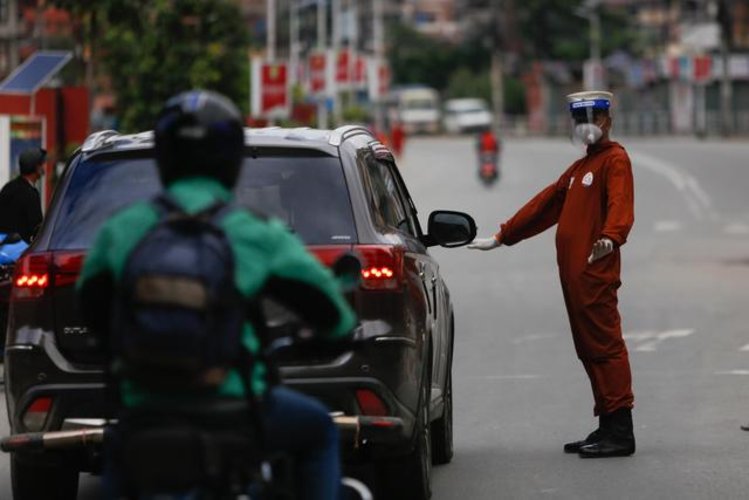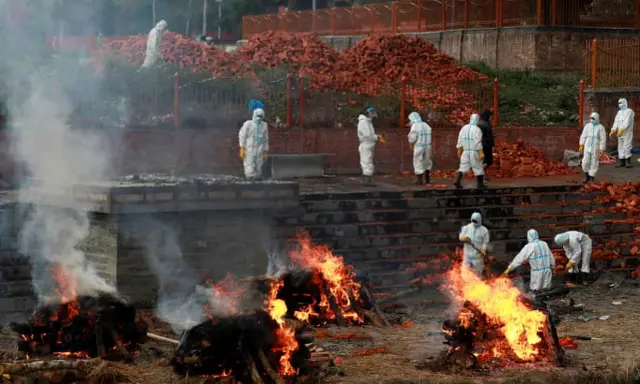By APD writerShristi
Nepal reported nearly 10,000 COVID-19 cases on Thursday, the highest single-day tally since the first case on January last year. Nepal had reported over 7,000 daily cases earlier this week.
According to the Ministry of Health and Population, the cases surged by over 127 percent this week compared to last week.
The per-day case was less than 100 in March, which indicates the huge surge, particularly in April, following the footsteps of the southern neighbor India. It has been reported that Nepal has 47 percent national positivity rate. With 54 deaths on Thursday, the country’s death toll now stands at 3,529.
Experts believe the spike occurred following rise of cases in India, with whom Nepal shares open border, engagements of people in political and religious events, festivals and cultural processions and participation in weddings as it was the auspicious wedding season as per the Nepali calendar.

Mostly the southwestern region of the country that borders India has been badly affected by the second wave of the coronavirus. Besides, the Kathmandu Valley is the country’s worst-affected place with nearly 3,000-4,000 cases per day.
On Wednesday, International Federation of Red Cross and Red Cross Societies (IFRC) Nepal chairman Netra Prasad Timsina said in the statement, "What is happening in India right now is a horrifying preview of Nepal's future if we cannot contain this latest COVID surge that is claiming more lives by the minute."
The Nepali government itself has accepted that the situation has deteriorated since the couple of weeks. On Monday, Nepali Prime Minister KP Sharma Oli made a televised addressed to the nation and urged the neighboring and friendly countries to help in health infrastructures including supplies of oxygen.
He appealed for help of diagnostic equipments and kits, oxygen therapy, critical care medicines to support the ongoing efforts to combat the pandemic. “We are of the view that vaccines and critical care medicines are global goods and everyone should have access to it,” he said.
The government is struggling to handle the pandemic as it lacks the emergency facilities like oxygen, ventilators and enough ICU beds. With the hospitals overwhelmed by patients across the country and lack of infrastructures, the Prime Minister also appealed for vaccines.
Nepal launched its inoculation drive on January 27 after Nepal received one million doses of Covishield gifted by India. The Chinese government donated 800,000 doses of Vero Cell that arrived in Kathmandu at the end of March.

As per the statistics, only around 1.2 percent of the total population have received both doses of vaccine. To be noted, in lack of enough vaccines, those who had received the first dose are still waiting for the second one. Around 5.6 percent of the population have received only their first shot.
Besides vaccine, poor health system is the major concern at the moment.
According to the statistics, the Himalayan country has around 1600 intensive care beds and less than 600 ventilators, which is no way sufficient for the country with the 30 million populations. Regarding health professionals, there are 0.7 doctors per 100,000 people, which is again minimal.
Amid this reality, the health ministry last week stated that it was unable to cope the situation indicating that it is almost in brink of collapse. Health Minister Hridayesh Tripathi had earlier warned of 15,000 new cases a day by July, but it seems this number will be here any time soon, probably by next week or so.
To control the situation, the local administrations have seized borders and imposed lockdowns and prohibitory orders in major cities across the country. Kathmandu valley is in prohibitory order since last 9 days halting all the transportation and businesses. The domestic and international flights have been halted since this week.
"The government is repeating the same mistake as last year. Lockdown cannot be the only solution in breaking virus chain, the other measures like vaccination should go together," Dr Sameer Mani Dixit, a public health expert, suggested.
Not limited to capital and borders, the virus has also reached the Himalayas in the prime expedition season as many climbers have been evacuated from Everest and Dhaulagiri after reports of outbreak at the base camps.
The government has entrusted the Nepal Army with the responsibility of developing and expanding necessary health infrastructures in all the 7 Provinces including in the Kathmandu valley. Some private efforts are also being held to support in setting up the hospital-like beds in local level, but it's minimal.
Earlier, the government has ordered 20,000 oxygen cylinders from China, which are expected to come in installments from next week.
Dr Anup Subedee, an infectious disease consultant, told APD, "Massive testing, early detection, isolation, and contract tracing are the most fundamental steps to control the spread of the virus."
(ASIA PACIFIC DAILY)
 简体中文
简体中文

